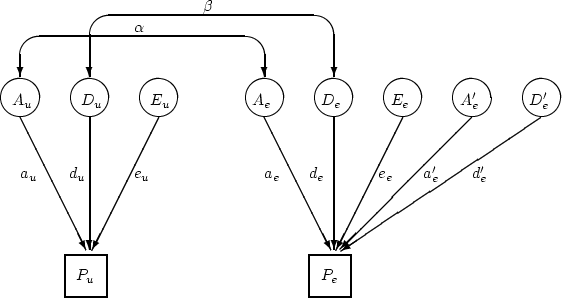



Next: 2 Model-fitting Results
Up: 5 G E Analysis
Previous: 5 G E Analysis
Index
The data were collected from twins enrolled in the Australian National
Health and Medical Research Council Twin register. In this sample, mailed questionnaires were
sent to the 5,967 pairs of twins on the register between November 1980
and March 1982 (see also Chapter 10). Among the items on
the questionnaire were those from the state depression scale of the
Delusions-Symptoms States Inventory (DSSI; Bedford et al.,
1976) and a single item regarding marital status.
The analyses performed here focus on the like-sex MZ and DZ female
pairs who returned completed questionnaires. The ages of the
respondents ranged from 18 to 88 years; however, due to possible
differences in variance components across age cohorts, we have limited
our analysis to those twins who were age 30 or less at the time of
their response. There were 570 female MZ pairs in this young cohort,
with mean age 23.77 years (SD=3.65); and 349 DZ pairs, with mean age
23.66 years (SD=3.93).
Using responses to the marital status item, pairs were subdivided into
those who were concordant for being married (or living in a marriage
type relationship); those who were concordant for being unmarried; and
those who were discordant for marital status. In the discordant
pairs, the data were reordered so that the first twin was always
unmarried. Depression scores were derived by summing the 7 DSSI item
scores, and then taking a log-transformation of the data [
 ] to reduce heteroscedasticity. Covariance matrices of
depression scores were computed for the six zygosity groups after
linear and quadratic effects of age were removed. The matrices are
provided in the Mx scripts in Appendices
] to reduce heteroscedasticity. Covariance matrices of
depression scores were computed for the six zygosity groups after
linear and quadratic effects of age were removed. The matrices are
provided in the Mx scripts in Appendices ![[*]](crossref.png) and
and ![[*]](crossref.png) , while the correlations and sample sizes are
shown in Table 9.3. We note (i) that in all cases, MZ
correlations are greater than the corresponding DZ correlations; and
(ii) that for concordant married and discordant pairs, the MZ:DZ ratio
is greater than 2:1, suggesting the presence of genetic dominance.
, while the correlations and sample sizes are
shown in Table 9.3. We note (i) that in all cases, MZ
correlations are greater than the corresponding DZ correlations; and
(ii) that for concordant married and discordant pairs, the MZ:DZ ratio
is greater than 2:1, suggesting the presence of genetic dominance.
Table 9.3:
Sample sizes and correlations for Australian female
twin depression data.
| Zygosity Group |
N |
r |
| MZ - Concordant single |
254 |
0.409 |
| DZ - Concordant single |
155 |
0.221 |
| MZ - Concordant married |
177 |
0.382 |
| DZ - Concordant married |
107 |
0.098 |
| MZ - Discordant |
139 |
0.324 |
| DZ - Discordant |
87 |
0.059 |
Before proceeding with the G  E interaction analyses,
we tested whether there was a G - E correlation involving
marital status and depression. To do so, cross-correlations between
twins' marital status and cotwins' depression score were computed. In
all but one case (DZ twin 1's depression with cotwin's marital status;
E interaction analyses,
we tested whether there was a G - E correlation involving
marital status and depression. To do so, cross-correlations between
twins' marital status and cotwins' depression score were computed. In
all but one case (DZ twin 1's depression with cotwin's marital status;
 ,
,  ), the correlations were not significant. This
near absence of significant correlations implies that a genetic
predisposition to depression does not lead to an increased probability
of remaining single, and indicates that a G - E correlation
need not be modeled.
), the correlations were not significant. This
near absence of significant correlations implies that a genetic
predisposition to depression does not lead to an increased probability
of remaining single, and indicates that a G - E correlation
need not be modeled.




Next: 2 Model-fitting Results
Up: 5 G E Analysis
Previous: 5 G E Analysis
Index
Jeff Lessem
2000-03-20
 ] to reduce heteroscedasticity. Covariance matrices of
depression scores were computed for the six zygosity groups after
linear and quadratic effects of age were removed. The matrices are
provided in the Mx scripts in Appendices
] to reduce heteroscedasticity. Covariance matrices of
depression scores were computed for the six zygosity groups after
linear and quadratic effects of age were removed. The matrices are
provided in the Mx scripts in Appendices ![[*]](crossref.png) and
and ![[*]](crossref.png) , while the correlations and sample sizes are
shown in Table 9.3. We note (i) that in all cases, MZ
correlations are greater than the corresponding DZ correlations; and
(ii) that for concordant married and discordant pairs, the MZ:DZ ratio
is greater than 2:1, suggesting the presence of genetic dominance.
, while the correlations and sample sizes are
shown in Table 9.3. We note (i) that in all cases, MZ
correlations are greater than the corresponding DZ correlations; and
(ii) that for concordant married and discordant pairs, the MZ:DZ ratio
is greater than 2:1, suggesting the presence of genetic dominance.